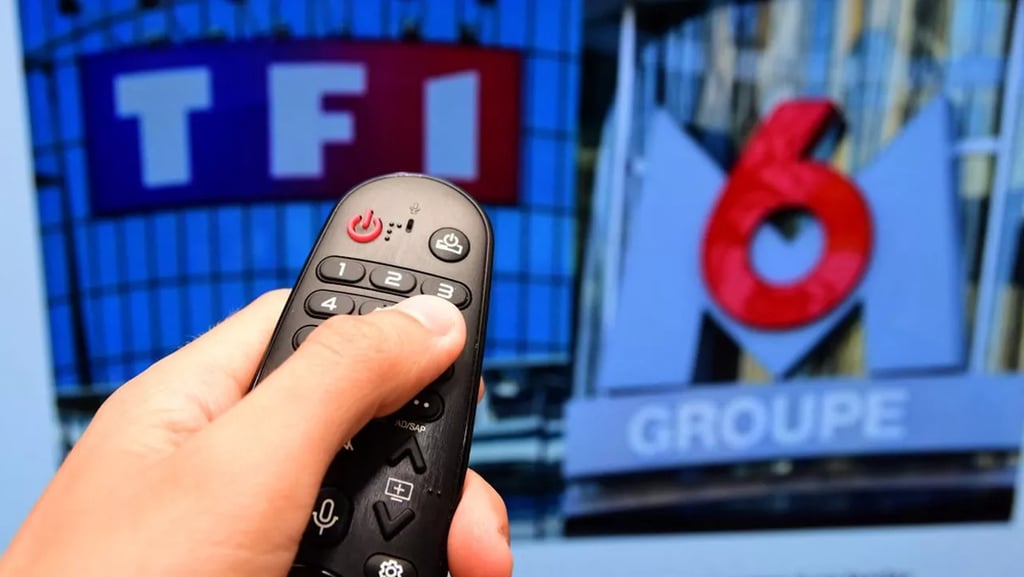TF1 + M6 + Amazon: targeting is improving, but confidence is stagnating. And that's where everything will be decided.Your blog post
On 5 November, TF1 and M6 announced an unprecedented partnership with Amazon around a shared ‘clean room’ — Amazon Publisher Cloud — presented as a minor Ad-Tech revolution. The promise is simple: to better target campaigns broadcast on TF1+ and M6+ by cross-referencing viewing data with Amazon purchase signals. On paper, it's clever. In reality, it's incomplete. And above all, it shows how much the industry still confuses precision with persuasion. Because let's be blunt: the advertising crisis is not a targeting crisis. It's a crisis of confidence. And targeting — even boosted by Amazon data — does not restore confidence.
Stéphane LE BRETON
11/15/20256 min read


(c) Illustration Romain Doucelin/Hans Lucas via AFP - Les Echos
Targeting is improving, but so is scepticism
The TF1/M6/Amazon initiative is part of a clear industrial strategy: if audiences are fragmenting and switching to streaming, we will seek out data to stay in the race.
The idea: to win back market share from social media platforms and digital giants by offering advertisers more ‘engaged’ audiences that are closer to the moment of purchase and better segmented.
And the context proves them right... but only on part of the issue.
In June 2024, streaming already accounted for 40.3% of total time spent watching television, according to Nielsen's The Gauge, an all-time record.
In May 2025, another symbolic shift occurred: streaming surpassed traditional television for the first time, accounting for 44.8% of TV usage compared to 44.2% for broadcast and cable combined.
At the same time, groups such as Warner Bros. and Paramount recorded double-digit declines in their traditional television revenues (–18% and –13% in certain quarters of 2024), confirming that linear television alone is no longer enough to finance the party.
In France and Europe, it's the same story:
Digital has accounted for the majority of media investment in France since 2022, and is expected to reach nearly 69% of media spending by 2028.
In 2024, the French advertising market grew by +7.7%, driven by digital and the Olympic Games, while traditional TV saw its relative share erode in the mix.
At European level, digital advertising exceeded €118.9 billion in 2024, up 16% year-on-year, confirming the structural shift in budgets towards connected screens.
In this landscape, the reaction of television broadcasters is logical: if television is losing ground, it will be ‘rearmed’ with platform-style targeting. Hence the convergence of models:
Google has DV360
Meta has its ecosystème AEM / CAPI
The Trade Desk s’appuie sur ses graphes d’identité propriétaires
Amazon pousse son stack retail media jusque dans la TV connectée… et désormais chez TF1+ et M6+ avec Amazon Publisher Cloud
Ce qui change avec ce partenariat, c’est que les régies TV françaises embrassent officiellement le même paradigme : “plus de data” pour compenser “moins d’attention” et “moins de revenus linéaires”.
What changes with this partnership is that French television ad sales houses officially embrace the same paradigm: ‘more data’ to compensate for ‘less attention’ and ‘less linear revenue’.
Except that: Data cannot fix what it does not touch: the credibility of the message.
Yes, data targets better. Yes, it optimises GRPs and segments. Yes, it reassures CFOs with attractive dashboards.
But on the ground, on the public side, the figures tell a different story:
Nielsen shows that 64% of consumers actively take steps to avoid adverts on free, ad-supported video services (channel hopping, multitasking, etc.), and 59% say they are willing to pay to avoid adverts altogether.
At the same time, BrightLocal's local consumer review survey reminds us that 98% of consumers read online reviews at least occasionally before choosing a local business, and that 76% read them ‘always’ or ‘regularly’.
The same family of studies shows that a majority of consumers lose confidence in a company when they see mostly negative reviews, a sign that the decision is no longer based on exposure, but on perceived evidence.
In other words: targeting has never been so sophisticated... and never has there been so much ad avoidance.
Reliable studies confirm the decline:
Nielsen's Global Trust in Advertising report reminds us that recommendations from friends and family remain the most reliable channel, ahead of all forms of advertising. ‘Online consumer opinions’ come in just behind, far ahead of banners, mobile formats or other display formats.
Yes indeed :
Targeting is improving,
media piping is becoming increasingly sophisticated,
and combining viewing data with Amazon purchase signals allows for optimised planning.
But data does not make advertising more credible. It does not repair mistrust of brand messages. It does not, in itself, prove that the product delivers on its promises. And this is not a technical detail: it is the real divide in the market.
We have built very complex architectures to determine who to talk to, where and when. But we have done very little work on ‘why this person should believe what we are telling them’.
The current crisis is therefore not a crisis of targeting. It is a crisis of message legitimacy.
A useful partnership... but one that reinforces strategic dependence
Let's be clear: for TF1 and M6, partnering with Amazon makes sense. Streaming platforms need to make their model profitable, SMEs are looking for simple and effective solutions, and the market demands responsible targeting.
The deal therefore ticks all the operational boxes at the moment.
But behind the immediate effectiveness lies an obvious strategic risk: by integrating Amazon signals, channels are becoming slightly more dependent on an ecosystem that has captured a large share of advertising value over the past decade.
A brief reminder of recent history:
Social media captured attention (time spent, short formats, engagement).
Amazon captured the conversion (retail media, internal search, real-time purchase data).
Television, weakened by the erosion of linear broadcasting, is now attempting to regain ground thanks to data.
This move makes sense, but it creates asymmetry: as soon as media value depends mainly on external data, whoever owns the data controls the value chain.
And in this partnership, it is not TF1 or M6 that owns the purchase data: it is Amazon. But if the history of digital technology has taught us one thing, it is this:
📌 Whoever controls the data controls the future dependence of the market.
But above all, this debate over ‘who has the best data?’ obscures a key point that platforms cannot address: proof that advertising works.
A clean room can bring signals closer together. It can refine segments. It can improve attribution models. But it cannot:
make a message more credible,
build trust,
incorporate certified evidence into an advertisement,
or clearly show on screen why a product is worth buying.
And it is precisely this third pillar — visible, verifiable evidence integrated into the media — that the market has still not resolved. In summary
✔️ Amazon helps television target its audience more effectively.
❌ But Amazon is not helping him to be more convincing
And it is this divide — relevance versus evidence — that will determine the winners of the next decade.
The advertising crisis is not a data crisis. It is a credibility crisis.
For ten years, all studies have been hammering home the same message:
Trust in TV adverts is declining year after year.
Attention spans are fragmented into micro-fragments, reducing the time available for persuasion.
Consumers systematically check reviews before buying (95% according to BrightLocal).
Branded messages are losing authority, often perceived as exaggerated or out of touch.
Above all, social proof now dominates brand messaging.
To put it plainly: the problem is not that adverts are poorly targeted... it is that people no longer believe them spontaneously.
Technology can optimise distribution, refine segments and enrich media plans. But it does not answer the essential question that crosses every household, every screen and every purchasing decision:
“Why should I believe what this brand tells me?"
In an environment saturated with messages (consumers are exposed to more than 15,000 commercial stimuli per day), persuasion no longer relies on repetition or algorithmic personalisation.
It is based on something simpler, but infinitely more powerful: evidence.
Human signals. Authentic. Verifiable. Understood in a second.
It is this combination — Attention + Trust — that truly triggers conversion. And certainly not the combination of Attention + Data, however sophisticated it may be.
The next frontier: integrating proof directly into advertising
The next battle will not be won on the field of targeting. It will be won on the field of visible trust.
The industry has tried everything:
behavioural triggers
creative AI
cross-device
DCO
attribution modelling
proprietary clean rooms
What it has not yet industrialised is certified proof in advertising creations. However:
95% of people read reviews before buying
Reviews increase sales by an average of +18%
The presence of proof increases attention by +20 to +30%
QR codes drastically reduce the ‘last mile’ between exposure and action
And the ISO 20488/NF522 standard creates a credible framework for certified reviews
Television, newspapers and cinema have something that social media platforms will never have: the power of context. Add proof to that, and you regain what social media platforms have taken away from you: trust.
Targeting won't save advertising. Trust will.
The TF1 + M6 + Amazon alliance is an important, long-awaited, strategic move. It modernises French television. It opens the doors to retail media. It extends performance.
But it does not address the core of the problem: the credibility deficit of advertising.
The next major market revolution will not come from a DSP, a clean room or an identity graph.
It will come from a simple, forgotten, almost banal principle: people believe other people. They no longer believe advertisements. The solution is there.
And the entire future value of advertising lies precisely at this intersection: where proof meets media.
Our commitment
Reviving trust in brand advertising through innovation.
CONTACt
info@buytryshare.com
+33 6 83 53 70 41
© 2025. SLB consulting. All rights reserved.



